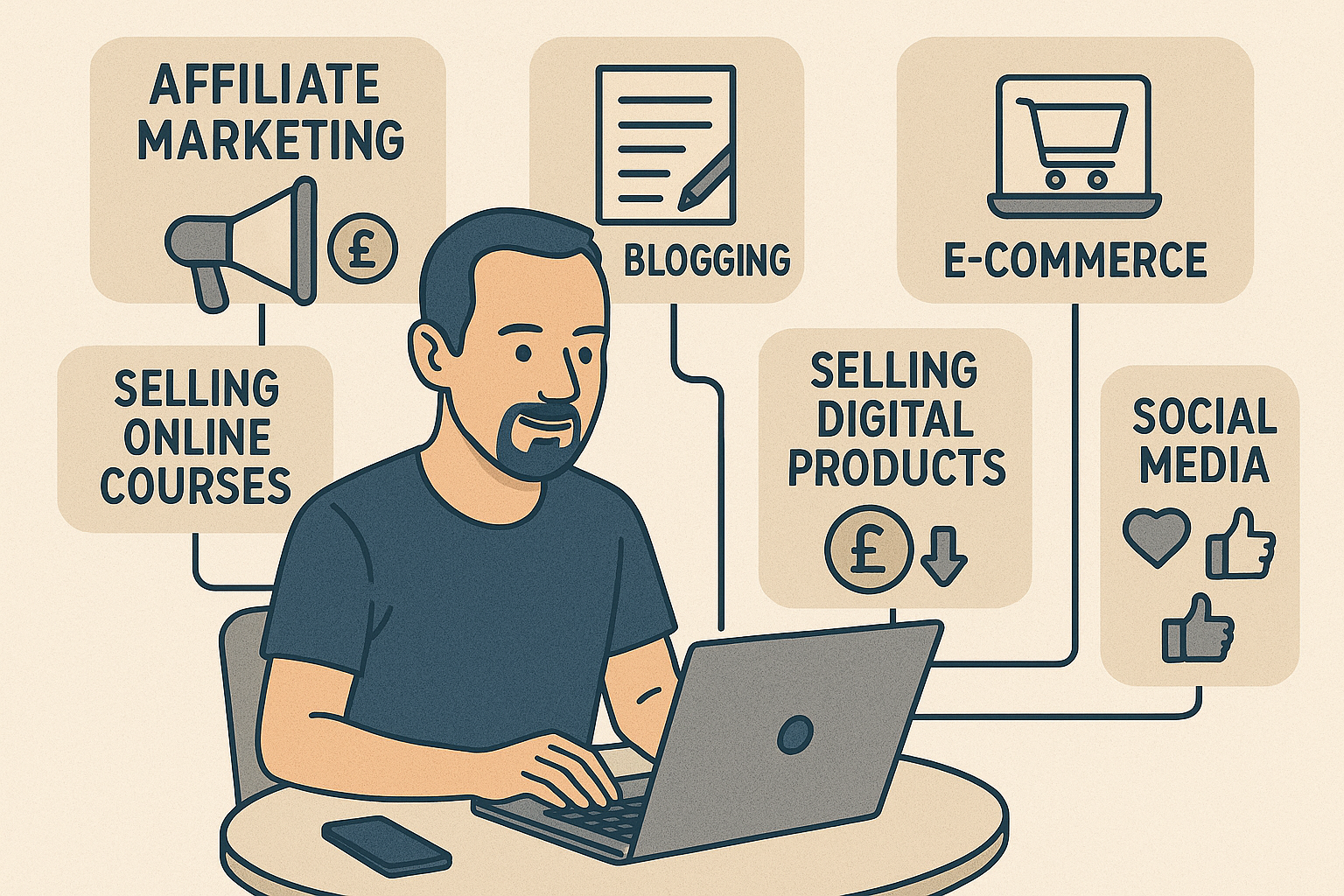How to make money online in your 50s
Hitting your 50s can feel like standing at a crossroads. You’ve worked hard for decades, the kids are growing up, and the future can seem uncertain. Bills keep rising, and the government keeps moving the goalposts when it comes to retirement age. Then there’s the issue of job security, with companies increasingly replacing human labour with machines and AI taking over roles that were once firmly in human hands.
You may not be able to change the past, but you can shape a better future for yourself and your family as you head towards your 60s. The online world now offers more opportunities than ever, especially for those of us with life experience and a solid work ethic. Whether you’re still grafting or just looking to future-proof your finances, there are real ways to earn online, from the comfort of your own home.
In this article, I’ll walk you through proven ways to make money online in your 50s, covering everything from affiliate marketing and e-commerce to blogging, online courses, and more. This isn’t about overnight success or flashy promises—it’s about building something long-term, smart, and sustainable that could help you take control of your future. Ready to get stuck in?
My Story
Before we dive into the nitty-gritty, let me give you a bit of background, because I’m not some tech wizard or marketing guru. I’m an unskilled worker who didn’t do great in school and spent most of my life doing manual jobs. Over the years, I’ve worked on the railways, in factories, delivered parcels, and even worked as a tree surgeon. Like many of you reading this, I was just trying to keep the bills paid and the family fed.
In 2009, I built my first ever website for a small delivery business I was running. It was basic, but it got me interested in how websites worked. Fast forward to 2018, and I started a blog, specifically around something I was passionate about: electric bikes. I started sharing what I knew, reviewing bikes I’d ridden, and writing guides for other riders. That little side project turned into a full-time business that, at its peak, was getting over 250,000 visitors a month from around the world and earning me a steady £4,000–£5,000 per month from ad revenue and affiliate commissions.
But it wasn’t all plain sailing. In 2023, Google changed how it ranked content, and my traffic took a massive hit almost overnight. Like many independent creators, I found myself pushed out by AI-generated answers and big sites dominating the search results. It was a tough blow after years of hard work — but it also pushed me to adapt, learn new skills, and explore other ways of earning online.
All of that happened while raising five daughters and battling ongoing mental health issues. It wasn’t easy, but it was worth it. If I can do it, then so can you. All it takes is consistency, a willingness to learn, and a bit of self-belief.

What Does “Making Money Online” Actually Mean?
When people hear the phrase ‘make money online’, it often sounds a bit dodgy or too good to be true, like some scammy advert that promises thousands a week for doing nothing. But the truth is, making money online simply means earning an income using the internet as your platform. You’re still putting in the work—you’re just doing it differently.
Instead of clocking in at a job site or jumping in the van at 6 am, you’re building something digital. That could mean setting up an online shop, writing blog posts, creating videos, selling digital products, or promoting other people’s products for commission. Some methods take more time and effort than others, but the end goal is the same: creating income streams that either bring in extra cash on the side or eventually grow into something more substantial—maybe even your main income.
For people in their 50s, especially those used to physical jobs or long hours, this shift can feel strange at first. But with a bit of patience and the right mindset, it’s doable. And the best part? Once it’s set up, some of it can keep earning money even when you’re not actively working—this is called ‘passive income’. You do the work and build the foundations, and it keeps paying you back over time.
In the next sections, we’ll break down some of the best, most realistic ways to make money online in your 50s. These aren’t get-rich-quick schemes—they’re proven methods that, with consistent effort, can change your financial future.

1. Affiliate Marketing
Affiliate marketing is one of the simplest ways to make money online—and it’s where I started. In a nutshell, you earn a commission every time someone buys a product through a special link you’ve shared. You don’t need to create or ship anything. You’re simply recommending products you believe in and helping people find things they need.
Let’s say you’ve discovered a fantastic kitchen gadget, a power tool, or an online course that helped you. If that company has an affiliate programme (many do—like Amazon, eBay, and thousands of other brands), you can sign up, get a unique tracking link, and earn money each time someone clicks your link and makes a purchase.
Once you’ve chosen a product or brand to promote, you can share your affiliate links in blog posts, YouTube videos, social media content, or even email newsletters. The more useful and authentic your content, the more likely people are to trust your recommendation and click your link.
Affiliate marketing isn’t about being “salesy”. The best results come from being honest, helpful, and passionate about what you’re promoting.
How Do I Start?
Start by choosing a topic you know and love—like DIY, home cooking, fashion, fitness, or even tech. This will be your “niche”. Then, look for affiliate programmes that offer products or services in that area. Amazon Associates is a great option for beginners, but you can also explore sites like Awin, CJ Affiliate, or PartnerStack to find other brands.
Once you’ve joined a programme, create useful content that helps people, like blog posts, YouTube videos, or social media tips. Add your affiliate link when you mention a product. The more helpful and trustworthy you are, the more likely people are to click and buy.
You don’t need to be a marketing expert—just be yourself, share your knowledge, and aim to solve problems or answer questions people might have.
Pros and Cons
Pros
✔️ No need to create or manage a product inventory
✔️ Can be added to blogs, social media, or YouTube easily
✔️ Scalable – the more content you create, the more you can earn
Cons
❌ Takes time to build traffic and trust
❌ Commissions on cheaper items can be small
❌ Some affiliate links may have short expiry times
Why This Works for Over 50s
Many over-50s have years of experience with hobbies, interests, or specialist knowledge—from DIY and home cooking to fitness or finance. That knowledge has real value online. If you’re already using tools, gadgets, or services you love, why not recommend them to others and earn a bit of income at the same time?
It’s a flexible way to make money that doesn’t require a huge upfront investment—just your experience, some time, and a willingness to share what you know. Plus, once you’ve created content with affiliate links, it can continue earning money in the background for months—or even years.

2. Blogging
Blogging is one of the most powerful and underrated ways to make money online, especially for people in their 50s with a lifetime of experience, stories, or advice to share. A blog is essentially your corner of the internet, where you can write about anything you’re passionate about—whether that’s parenting, fishing, health tips, gardening, or even trainspotting.
But blogging isn’t just a hobby—it can become a serious income stream. You can earn money through affiliate links, display adverts, sponsored content, and even by selling your products or services in the future. The real key is consistency and sticking to a specific topic (known as your “niche”), so visitors know what to expect when they land on your site.
One of the best things about blogging is that your content keeps working for you over time. A well-written blog post can rank on Google and bring in traffic for months or even years. At the height of one of my blogs, I was getting over 250,000 monthly visitors—much of it from posts I’d written months earlier. That traffic turned into affiliate sales, ad revenue, and regular offers from companies who wanted to collaborate.
And don’t worry—you don’t need to be a tech whizz to get started. Platforms like WordPress, Wix, or Squarespace make it easy to set up a smart-looking site with minimal fuss. You can even start slowly, posting once a week in your spare time.
Blogging does take patience, but over time, it becomes a powerful way to build authority, create opportunities, and earn a flexible income from anywhere.
How Do I Start?
Start by choosing a topic you care about and have knowledge in—it could be anything from vintage cars to home cooking or personal finance. This becomes your niche. Then, pick a blogging platform (WordPress is the most popular), choose a simple template, and write your first few posts offering tips, advice, or helpful information. If you’re not confident with website design, contact us, and we’ll build one for you – our prices start at just £199 including 12-month hosting and a free domain name.
Focus on writing content that solves problems, answers questions, or inspires others. As your blog grows, you can add affiliate links, apply for advertising networks like Google AdSense, or even get paid for sponsored posts.
If writing feels daunting, AI writing tools can help you brainstorm ideas or tidy up your grammar. But your personality and experience are what truly make your blog unique.
Pros and Cons
Pros
✔️ Very low-cost to start – just a domain and hosting
✔️ You own the platform and control your content
✔️ Ideal for building authority and trust in a niche
Cons
❌ Takes time to gain traffic and make money
❌ Needs regular updates and content to stay relevant
❌ Can feel overwhelming at first without a clear plan
Why This Works for Over 50s
People over 50 often have decades of experience in work, hobbies, or life in general—blogging is a fantastic way to share that wisdom. Whether it’s recipes from your kitchen, advice from your career, or personal stories, your voice matters.
Blogging is also flexible—you can write at your own pace and grow your audience over time. It’s ideal for those looking for a creative outlet, a new challenge, or a way to generate steady income in semi-retirement.

3. Social Media: Turn Your Personality or Passion into Profit
Social media isn’t just for watching funny videos or keeping up with the grandkids—it can be a genuine way to earn money online, especially if you’re happy to share your personality, knowledge, or day-to-day life. Platforms like YouTube, Facebook, Instagram, TikTok, and Pinterest all offer different ways to earn once you’ve built a bit of an audience. And no, you don’t need to be a 20-something influencer or do silly dances!
Each platform has its strengths, and the best one for you depends on what you’re comfortable doing. Here’s how the main ones work:
YouTube
Perfect if you’re confident on camera (or even just with voiceover). YouTube is excellent for building a long-term income stream with video content in a specific niche like DIY tips, fitness over 50, product reviews, or storytelling. You can earn money via:
- Ad revenue through the YouTube Partner Programme (once you hit 1,000 subscribers and 4,000 watch hours)
- Affiliate links in your video descriptions
- Sponsorships from relevant brands
- Selling products or services
Great for connecting with niche or local communities. Monetisation often comes from Facebook Pages and Groups. Once you’ve grown an audience, you can earn through:
- You can sign-up with Meta for creators.
- In-stream ads on longer videos (if eligible)
- Affiliate links in posts or lives
- Promoting your blog, website, or products
- Running niche Groups that attract brands or support your own offerings
Instagram
Ideal for visual content—think food, crafts, vintage clothes, pets, and more. Money-making opportunities include:
- Brand sponsorships (once your account gains traction)
- Affiliate links (via bio tools or story links)
- Selling digital products or services
- Promoting an online store, course, or blog
TikTok
Not just for the kids! Many 40+ and 50+ creators are thriving here. If you’ve got humour, advice, or stories to share, you can earn via:
- The TikTok Creator Fund (once you meet the criteria)
- TikTok Shop Affiliate (promote products directly)
- Brand sponsorships and affiliate marketing
- Driving traffic to your blog, YouTube, or store
Pinterest
Quietly powerful, especially for content that’s visual or info-rich. It’s a great way to:
- Drive traffic to your blog or shop
- Promote digital products (like planners or downloads)
- Use affiliate links (mainly Amazon/eBay allowed)
Popular niches include crafts, recipes, home décor, fashion, and travel.
How Do I Start?
Pick one platform to begin with—ideally, the one you already use or enjoy the most. Choose a theme or topic that you know about or enjoy (your niche), and start creating content around that. You don’t need fancy equipment—just a smartphone and some consistency.
Be relatable and helpful. Whether you’re showing off vintage finds, cooking budget meals, or sharing cycling tips for over-50s, there’s an audience out there for it. As you grow your followers, look for ways to introduce affiliate links, sponsorships, or promote products.
And remember: people love authentic content. Just be yourself.
Pros and Cons
Pros
✔️ Free or very low-cost to start
✔️ Multiple platforms and ways to earn
✔️ Builds trust and community around your personality
Cons
❌ Takes time to grow a following
❌ Can feel overwhelming managing multiple platforms
❌ Algorithms change—so flexibility is key
Why This Works for Over 50s
People over 50 have something many younger creators don’t—life experience, practical wisdom, and a more relatable voice for a mature audience. Whether you’re sharing home tips, honest reviews, or simply stories from your life, you can build a strong following.
Social media also suits flexible lifestyles. You can create content when it suits you, from home, with very little upfront cost. Plus, it’s fun—many over-50 creators find it rewarding and even energising.

4. Create an Online Course: Share What You Know and Get Paid for It
If you’ve spent years mastering a skill, trade, or hobby, why not turn that knowledge into a steady income stream by creating an online course? You don’t need a degree or teaching background—just the ability to explain something useful in a clear, step-by-step way.
Whether it’s DIY, parenting, baking, gardening, or even navigating midlife with confidence, there’s likely someone out there willing to pay to learn what you know. Courses are hugely popular, with people buying tutorials on everything from pet training to digital art to managing money. It’s one of the best ways to package up your knowledge and get paid over and over again.
Online courses offer real flexibility and passive income potential. You create the course once, and it can continue to earn for months or even years. Platforms like Teachable, Udemy, and Skillshare make it easy to host and sell your course. If you don’t fancy being on camera, you can use slideshows, downloadable PDFs, screen recordings, or even AI avatars that deliver your content professionally.
How Do I Start?
Start by picking a topic you know well and that others might find useful—something practical, inspiring, or time-saving. Break it down into lessons and think about how you’d explain each step in plain English.
Use your smartphone or laptop to record videos or screen recordings, and keep things simple. Free tools like Loom or OBS Studio are perfect for this. Once you’ve created the course, you can host it on platforms like Teachable, Udemy, or your website.
To attract students, focus on marketing:
- Share tips and teasers on platforms like YouTube, Instagram Reels, or TikTok
- Build an email list and offer a free mini-course or downloadable guide
- Post in relevant Facebook groups
- Add your course to your blog if you have one
This builds trust and gives people a taste of your teaching style, making them more likely to buy the full course.
Pros and Cons
Pros
✔️ One-time creation, long-term earnings
✔️ Great way to turn knowledge into income
✔️ Can be done with free tools and basic tech
Cons
❌ Requires effort upfront to create content
❌ Needs ongoing marketing to keep sales coming in
❌ Competition can be high in popular niches
Why This Works for Over 50s
You’ve got life experience, skills, and a calm, clear communication style—all of which make you an ideal online teacher. People often prefer learning from someone relatable and knowledgeable, rather than flashy or overly technical.
Plus, creating courses is flexible and low-pressure. You work at your own pace, and once the course is live, you can continue earning even while you sleep.

5. Print-on-Demand
If you’re creative—or even just have a few clever ideas—print-on-demand (POD) is a fantastic way to start an online business without worrying about stock, storage, or post office queues. You simply upload your design, choose the product (like a t-shirt, mug, or tote bag), and the printing company does the rest—printing, packing, and shipping it directly to your customer.
This is ideal for people who want to test the waters with e-commerce but don’t want the hassle of running a full-blown shop.
How Does It Work?
Print-on-demand is refreshingly simple:
- Create a design, slogan, or image (funny, niche, meaningful—whatever suits your style).
- Upload it to a POD platform like Redbubble, Printful, or Printify. Many of these also link directly to Etsy, Amazon, or eBay.
- Choose the products you want to sell—t-shirts, hoodies, mugs, posters, phone cases, cushions, and more.
- Promote your listings using social media, Pinterest, or a blog.
- When someone places an order, the platform prints and ships it. You earn a profit without lifting a finger.
No Artistic Skills? No Problem
You don’t need to be a designer or artist to succeed with POD. Many successful sellers create:
- Text-only designs with funny or thoughtful phrases
- Simple layouts using free tools like Canva
- Niche ideas (dog lovers, grandads, tradespeople, gardeners…)
- AI-generated art or royalty-free stock illustrations
Find a niche that speaks to you, and build a shop that reflects your humour, interests, or lifestyle.
Pros and Cons
Pros
✔️ No upfront investment or stock handling
✔️ Creative and fun side hustle
✔️ Works well alongside blogging, YouTube, or social media
Cons
❌ Lots of competition—niche targeting helps
❌ Takes time to see regular income
❌ Profit margins can be small unless you build a loyal audience
Why This Works for Over 50s
You don’t need to be a tech wizard or an artist. Just bring your creativity, humour, or life wisdom to the table. You can start small, build at your own pace, and run everything from a laptop or tablet. It’s a brilliant way to explore e-commerce with minimal risk—and who knows, you might even create a best-seller!

6. Amazon Kindle Direct Publishing (KDP)
You don’t need to be a bestselling author—or even call yourself a writer—to publish a book these days. With Amazon Kindle Direct Publishing (KDP), you can self-publish a book and earn money every time someone downloads or buys a copy.
Whether you’ve got a story to tell, advice to give, or a hobby you know inside out, there are people out there searching for exactly that. The beauty of KDP is that you write a book once, and it can go on earning for years to come. It’s a brilliant way to turn your experience, imagination, or interests into something that pays.
And it’s not just about full-length novels. Many successful self-publishers create short guides, journals, planners, or even colouring books. You can use free tools like Canva to design low-content books, or AI to help with illustrations for children’s stories. If you’ve got something to share, there’s probably a way to package it as a book.
How Do I Start?
Begin by choosing a topic you feel confident writing about—this could be a practical guide, your personal story, or a collection of creative fiction. You don’t need thousands of pages; even short books can sell well if they’re helpful or entertaining.
Once your book is written, you can format it using Amazon’s free tools or software like Reedsy. Canva is ideal for designing a simple but professional-looking cover. When you’re ready, upload your book to Amazon KDP, set your price, and hit publish. It will be available for Kindle and (if you choose) as a printed paperback too.
To promote your book and get it noticed, try:
- Posting helpful content or excerpts on your blog or YouTube channel
- Sharing in Facebook groups or forums related to your book’s topic
- Creating short videos or tips for TikTok or Instagram
- Building a small email list to promote new releases and offers
You can also learn some basic Amazon keyword research or try Amazon Ads once you’re confident.
Pros and Cons
Pros
✔️ Low-cost way to start earning online
✔️ Your book can sell forever—true passive income
✔️ You don’t need a publisher or prior experience
Cons
❌ Can take time to write and format
❌ Success often depends on marketing and keywords
❌ Sales may be slow at first without a niche or audience
Why This Works for Over 50s
If you’re in your 50s, you’ve probably got years of stories, lessons, or practical skills others would find helpful. You also bring calm, clarity, and authenticity—qualities many readers appreciate. Writing and publishing a book is also deeply rewarding—it boosts confidence and creates something lasting that can earn money while you sleep.
Whether it’s your life story, a how-to guide, or a low-content planner, self-publishing on Amazon is a smart and satisfying way to turn your words into income.

7. E-Commerce
Have you ever fancied the idea of running a shop without the overheads of rent, stockrooms, or tills? With e-commerce, you can set up a fully functioning online store from the comfort of home, and you don’t need to be tech-savvy to get started.
Thanks to platforms like Shopify, WooCommerce (on WordPress), BigCommerce, and Sellfy, building an online shop has never been easier. Whether you’re selling physical goods, digital downloads, or even personalised gifts, there’s a simple, flexible option to suit you.
You don’t need to reinvent the wheel—just find something people want to buy, put it in front of the right audience, and let your website do the heavy lifting.
How Do I Start?
Begin by choosing a platform:
- Shopify – A beginner-friendly, all-in-one solution. You pay a monthly fee, but it handles everything from hosting to payments.
- WooCommerce – A free plugin for WordPress. It’s more customisable but takes a little more time to set up.
- BigCommerce – Great for selling digital products, subscriptions, or a mix of both.
Next, decide what to sell. The trick isn’t to list random items and hope for the best. You want a product that solves a problem, follows a trend, or sparks joy—something people are actively searching for.
Use free tools to help spot what’s trending:
- Google Trends – See if interest in a product or niche is rising or falling
- TikTok Creative Centre – Discover viral products and what’s getting attention
- Facebook Ads Library – Peek at what competitors are advertising and how
- Amazon Movers & Shakers – Track what’s suddenly flying off the shelves
These tools give you insight into what’s hot before the masses catch on.
What is Dropshipping?
Dropshipping is a way to sell products without storing or shipping anything yourself. When someone buys from your site, the order is sent straight to your supplier, who ships it directly to your customer.
It sounds simple—and it can be—but there are some traps. Many beginners use overseas suppliers (like AliExpress), which often leads to slow delivery, poor packaging, and unhappy customers.
To do it properly:
- Choose UK- or EU-based suppliers for faster, more reliable shipping
- Use platforms like Avasam, Spocket, or Syncee to find vetted suppliers
- Consider private labelling (your brand on the product) for more trust and profit
Getting Visitors
A brilliant website means nothing without visitors. This is where social media can work wonders.
Platforms like TikTok, Instagram Reels, YouTube Shorts, and Pinterest are fantastic for getting free, organic traffic. What works best? Short, relatable videos that show your product in action—solving a problem, making life easier, or just being fun to use.
User-Generated Content (UGC) is king. These are short videos that feel natural, not salesy. You can film them yourself or pay a small fee for a creator to make them.
If you’ve got a bit of budget, Facebook and TikTok Ads can help you scale faster. Start small, test one product, and keep an eye on results.
Pros and Cons
Pros
✔️ Low barrier to entry—great for beginners
✔️ Can start small and scale at your own pace
✔️ Ideal for creative or product-focused people
Cons
❌ Takes time to find a winning product
❌ Dropshipping can cause headaches if done wrong
❌ Requires consistent marketing effort
Why This Works for Over 50s
If you’ve ever sold at a car boot sale or flipped something on eBay, this is your next-level version—online, scalable, and full of potential. It suits independent thinkers, hobbyists, and those with an eye for what people want. You’ve also got patience, common sense, and life experience on your side—great traits for building a small business.
Best of all, you can work on your terms, at your own pace, and turn something small into something surprisingly profitable.

8. Selling Digital Products
Want to earn money without packing parcels or chasing suppliers? Selling digital products could be your ideal online income stream. These are downloadable files—like planners, templates, eBooks, printables, or artwork—that customers can buy and use instantly
The beauty of it? You only need to create a product once, and you can sell it again and again with zero extra effort.
What Can You Sell?
Here are just a few ideas people in their 40s, 50s and beyond have turned into steady digital income:
- Printable planners (for budgeting, fitness, and daily routines)
- Digital wall art (Etsy-style designs customers print at home)
- Knitting, crocheting, or sewing patterns
- eBooks or recipe books
- Resume or CV templates
- Digital journals or affirmation cards
- Budgeting spreadsheets or business tools
If you’ve got a creative streak, a useful hobby, or practical know-how, then you’ve already got the ingredients for a great digital product. Tools like Canva make it easy to design professional-looking items—even if you’ve never used design software before.
Where Do I Sell Them?
- Etsy – A massive marketplace, especially good for creative or lifestyle-related downloads
- Gumroad – Great for selling guides, art, or niche digital products
- Payhip – A UK-friendly platform with no upfront costs
- Sellfy – Ideal for creators who want their own branded digital storefront
These platforms all handle payments and delivery automatically. Once your shop is set up, there’s very little ongoing work—perfect if you’re after passive income.
How Do You Attract Buyers?
Digital products don’t sell themselves—you need to get them seen. Here’s how people drive traffic:
- Pinterest – A powerful visual search engine. Pins can generate traffic for months (or even years).
- TikTok & Instagram Reels – Short videos showing how you use your product (e.g. “How I plan meals with my printable organiser”).
- Etsy SEO – Use strong titles and keywords in your listings to show up in Etsy searches.
- Blog or YouTube – Share tips, tutorials or reviews in your niche and link back to your products.
Focus on showing how your product helps someone, whether it saves time, adds beauty, or makes life easier.
Pros and Cons
Pros
✔️ No need to handle stock or shipping
✔️ Passive income potential once set up
✔️ Perfect for creative or organised individuals
Cons
❌ Some trial and error before you find what sells
❌ Can be competitive—good marketing matters
❌ Still requires time upfront to design and list products
Why This Works for Over 50s
Digital products are perfect if you’ve built up life experience, hobbies, or systems others can benefit from. Whether it’s meal planning, crafting, small business tools, or mindfulness resources, you’ve probably created something others would pay for.
And once you’ve uploaded your product and optimised your listing, it can keep earning in the background, giving you time to enjoy other things. No tech jargon or logistics needed, just a bit of creativity and a willingness to share what you know.

Final Thoughts
There’s no sugar-coating it — making money online isn’t some overnight magic trick. It’s not a case of slapping up a blog or a TikTok account and suddenly raking in cash by next week. Every method we’ve talked about — whether it’s affiliate marketing, blogging, e-commerce, social media, or selling digital products — takes time, dedication, and a fair bit of trial and error.
But here’s the key difference: you’re building something for yourself, not someone else’s business. When you put in the work, you’re planting seeds for your future — something that could offer not just financial breathing space, but real freedom later in life.
The truth is, you already have everything you need to get started. If you’ve worked your whole life in physically demanding or unskilled jobs, like I did, you’ve already developed the grit and persistence that many people never will. That same graft, applied to the online world, can open doors you never thought possible. Whether you want to earn a few hundred quid a month on the side or build a full-time income from home, it’s within your reach — but only if you’re willing to put in the effort and keep learning along the way.
There’s never been a better time to explore these options. The online world isn’t just for the young — it’s for anyone with a story to tell, a skill to share, or the willingness to try something new. Start small, stay consistent, and think long-term. You don’t need to do it all at once — just take that first step.
Because if someone like me — a former delivery driver with no qualifications and five daughters to raise — can do it… so can you.







